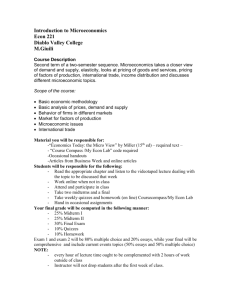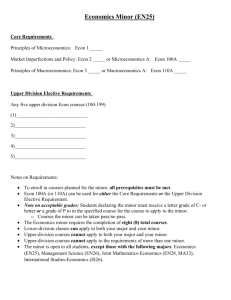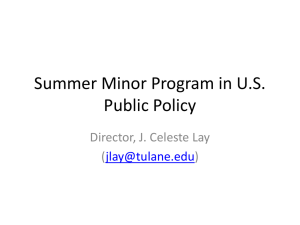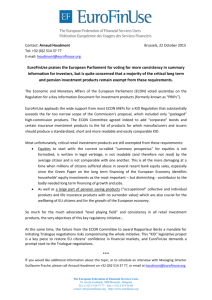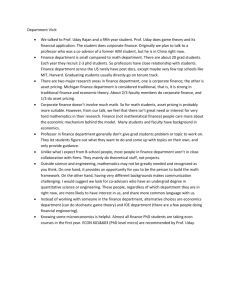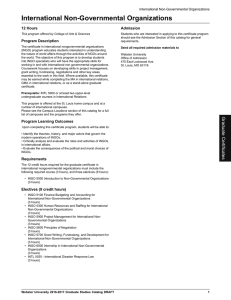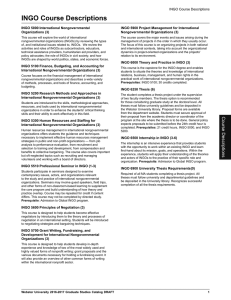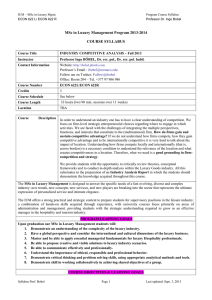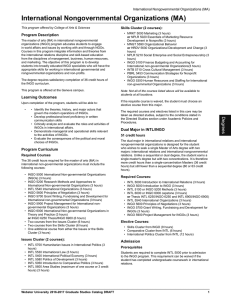The structure of your Industry Analysis Report should
advertisement
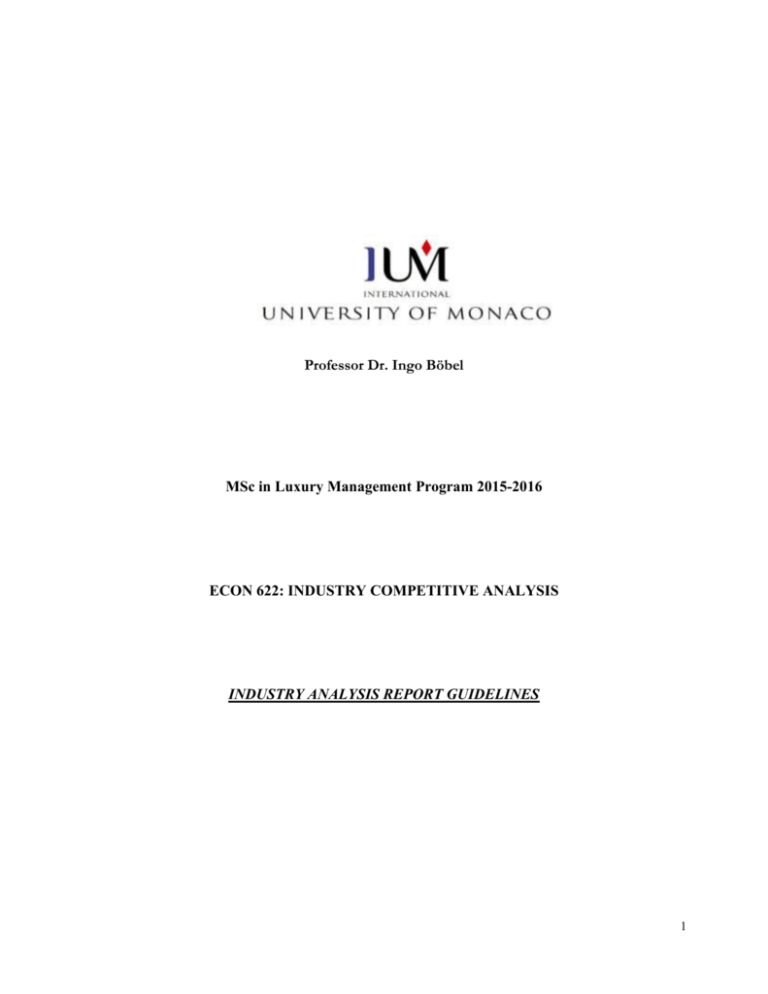
Professor Dr. Ingo Böbel MSc in Luxury Management Program 2015-2016 ECON 622: INDUSTRY COMPETITIVE ANALYSIS INDUSTRY ANALYSIS REPORT GUIDELINES 1 Prof. Dr. Ingo Böbel ECON 622: INDUSTRY COMPETITIVE ANALYSIS Fall 2015 Background A central part of the INDUSTRY COMPETITIVE ANALYSIS course is the INDUSTRY ANALYSIS REPORT. The report will be conducted as a group project. The aim of the project is for students to apply the concepts and frameworks learned in the course to a particular luxury industry or industry sector. The projects will also develop knowledge about the luxury industry/sector in an array of countries/locations that will inform students and add to the body of course materials over time. This memo outlines the expectations for the project, as well as the process by which the project will be conducted. Industry/Sector Selection The Program Director has assigned each student to a specific study group which typically consists of 4-5 students. Each student group has to choose one industry out of the following list of industries: Cosmetics Perfumes Real Estate Hotels Spas Arts Interior Design Gastronomy Wines & Spirits Fashion Leather goods Men’s ready to wear Watches Jewelry Cars Yachts Retail Shoes Final industry selections are due in the third week of class Topics To Be Addressed in the Industry Analysis Report 2 Prof. Dr. Ingo Böbel ECON 622: INDUSTRY COMPETITIVE ANALYSIS Fall 2015 The structure of your Industry Analysis Report should follow the outline below: 1. 2. 3. 4. 5. 6. 7. 8. Acknowledgements. Executive summary. Table of contents. Introduction. (number from here) Development (the main part of the report) Conclusion. References/ bibliography/works cited. Appendices (number from 1). Ad. 1. Acknowledgements You should concisely acknowledge all the people who have helped you to write your report. Ad. 2. Executive Summary The executive summary should contain at least the following paragraphs: 1. Definition of your sector or industry 2. Definition of the scope of your analysis 3. Presentation of your own research approach; what do you want to demonstrate (questions, issues, objectives, etc.) 4. Description of the methodology and models used 5. Presentation of the key findings 6. Conclusions drawn from your analysis. The Executive Summary should be short (should not exceed 2 pages), self-contained, conveying the same emphasis as your report, objective, precise and easy to read. It is meant as an overview of your work. Ad. 4. Introduction Your introduction should state your main research concerns. It should contain a full statement of your research questions and objectives and should provide a “route map” through the report (brief details of each chapter and an overview of your storyline). Ad. 5. Development The development of your thesis is the main body of the report and should be divided into several distinctive parts. It should start (1) with a critical and reflective review of the literature you have read and researched, (2) describe the methods you have used to collect data, and (3) report the results of your data collection. In addition, you should demonstrate your understanding of relevant theories learned during our course. Please keep in mind that we are looking for your own analysis and interpretation rather than a mere description of facts. Project Reviews 3 Prof. Dr. Ingo Böbel ECON 622: INDUSTRY COMPETITIVE ANALYSIS Fall 2015 During the Fall 2015 Term we shall have weekly Group – Progress Report Sessions during which each group can ask for advice (and can deliver a draft outline of the industry analysis that should include a Bibliography). You will receive individual feedback on your work. Exact dates will be announced in class. Recommendations following the discussions of the draft will, for ex., focus on - A clear definition of the industry or sector chosen and the scope of the analysis: Definition of sector (in terms of activities, products, etc) Size of industry both in volume and value If applicable, size of the specific sector or the section of the industry you are studying, both in volume and value Identification of the market structure Industry concentration Scope of your analysis: for most of you, you have no choice but to choose a global perspective, as most luxury companies operate and compete on a global scale! - Identification of the major players in the industry This is probably the most important step as it will affect all your findings and analysis. It is of utmost important that you not only identify and list ALL major players in your industry but also classify them: you need to construct some sort of typology. This is where you should start; this is also your “added value” and it will demonstrate your knowledge and understanding of the industry you are studying. Some of the key elements that you must look at are the following: - Size of the company : Turnover (in euros or dollars) Number of employees Number of stores - Performance of the company Market shares (it is a must! Most of the time they can be estimated from the data gathered regarding the industry as a whole) Financial indicators Specific indicators used by the industry - Activities performed by the company (cf. Value Chain & Supply Chain models) Fully integrated Manufacturing & Selling Distributer / Retailer Branding company 4 Prof. Dr. Ingo Böbel - ECON 622: INDUSTRY COMPETITIVE ANALYSIS Fall 2015 Scope of the company Local / National / Global reach After a careful review and analysis of those dimensions, you have to identify and select the criteria which you will use to describe the business landscape. - Identification of the trends shaping the business landscape Identify those macroeconomics & microeconomics variables that have a major impact on your industry Cf. PESTL model Cf. Kotler/Keller chapter on “Gathering information and scanning the environment” Once you have studied the Supply side (the firms & what they offer) you also need to review the Demand side (the consumers: who they are, what they want, etc). - The Five Forces Model should provide you with an opportunity to summarize your findings in a way that will help you understand the dynamics of the industry. It is critical that you identify the skills / competences / key factors of business a company must have to perform in the competitive environment you study. As for the “major players”, we expect you to be able to identify different categories of “buyers” and “customers”. Beware of using the proper vocabulary! Whenever you hesitate or are unsure of your conclusions, go back the basics! Check the definition of the concept and see, point by point, if the same principles apply. Another common mistake is to mix the levels of analysis: The industry level (that applies to all players) The sector level The “luxury” segment of the sector One specific player Ad. 6. Conclusion For each of your findings, you should have a conclusion. You should demonstrate whether you have answered your research questions, show the insights you have gained, draw conclusions and make judgments. The conclusion may also contain an analysis and discussion of your project, a consideration of your findings in the light of existing research, the limitations of your study and any recommendations for management and business practice, or for further research. Ad. 7. References References are listed alphabetically by author (or website title). Please note that you should also list references that you have cited in the text body of your report. 5 Prof. Dr. Ingo Böbel ECON 622: INDUSTRY COMPETITIVE ANALYSIS Fall 2015 It is expected that you seek out your own sources, you are free to exchange ideas on sources with other teams. All reports will be screened by an anti-plagiarism software. Ad. 8. Appendices Keep your appendices to a minimum. They should contain material which is “interesting to know”, but not “essential to know”, such as blank copies of questionnaires, interview schedules or observation schedules, etc. Do not use appendices to pad out your report. Presentations Final Oral presentations will take place during the week from December TBA. Each group will prepare a 20-minutes Powerpoint presentation which is followed by 10-minutes Q&A. It is expected that each member of the group will actively participate (speak) during the presentation! Slides should source quantitative information and be formatted so as to be clearly legible when printed in black and white. A printed out copy of the PPT presentation should be distributed to the jury members before the presentation. Final Written Report Each group will prepare a final written report. The due-date for the report will be announced in class, The following guidelines apply to the final written report: 6 Prof. Dr. Ingo Böbel ECON 622: INDUSTRY COMPETITIVE ANALYSIS Fall 2015 Please make sure that you use a lucid written style; avoid typos and misspelling words. (IMPORTANT HINT: BEFORE SUBMITTING YOUR REPORT, have your report read and corrected by at least one native English speaking person). Pay attention to the good structure of the document: for each section, there should be an introduction, a conclusion as well as transitions whenever necessary. Graphs and tables should be analyzed and commented. They should have a title, be numbered and have the source clearly cited. We will be looking for evidence of independent critical thinking, good application and understanding of theory, sharply focused analysis and ability to evaluate/argue/discuss the main issues raised by the project. Please pay attention to the aesthetic presentation of the document! The final report should be submitted in both hard copy and electronic form. The report can incorporate slides from the Power Point Presentation as exhibits. Please hand in: - 2 printed copies of the report The electronic versions of the report and the PPT-slides should be sent to ibobel@monaco.edu and to the program director (for systematic review by an anti-plagiarism software) 1. All reports will be double-spaced in 12-point type and should not exceed 40 pages including all tables, exhibits, references (but excluding appendices). Pages should be numbered consecutively. 2. Sources should be provided for all quantitative data and exhibits. References should be embedded in the text, i.e., (Bobel, 2010). A bibliography should be included at the end of the report using the following format: References: Porter, M. E. (1998). On Competition. Boston: Harvard Business School Press. Singhvi, L. (1999). “Venture Capital Industry in India: an Agenda for Growth”. Paper Presented at Asia/Pacific Research Center Conference on Accessing Venture Capital in India, Stanford University. 3. Footnotes should be used to further clarify points and to reference interviews and web sources. 4. A title page should be included which contains the report title, the names of the students on the team, the course name, and the date. 7 Prof. Dr. Ingo Böbel ECON 622: INDUSTRY COMPETITIVE ANALYSIS Fall 2015 5. Color graphics should be designed to be legible when the report is printed in black and white. Required Disclosures For purposes of equity in the evaluation of the project, teams are expected to disclose (1) any special or nonpublic access to information about the industry or sector, (2) whether any team members are nationals of the country or have resided in the country, and (3) whether team members have traveled to the country during the project period. Evaluation The Industry Analysis Report (written report + oral presentation) counts for 60% of your final course grade (for details see syllabus). In addition to the oral presentation and final report, students will be evaluated by the way they conducted all aspects of the project. Preparation, punctuality, and the conduct of review meetings with instructors will be evaluated. And once again: Please pay attention to the aesthetic presentation of the document you presented and the final report! Additional Sources How to conduct an industry analysis - http://www.sbtdc.org/pdf/industry_analysis.pdf Industry analysis: The Five Forces - http://www.extension.purdue.edu/extmedia/ec/ec-722.pdf Primer in Entrepreneurship: Industry and Competitor Analysis (slides) by U. Kaiser (Univ. Zurich) http://www.business.uzh.ch/professorships/entrepreneurship/teaching/past/hs08/primer/Kap5 primerentrepreneuruka.pdf 8

